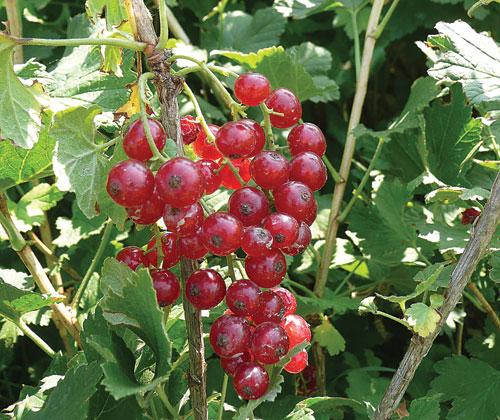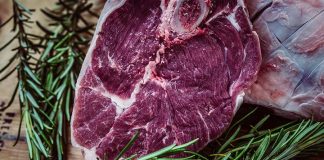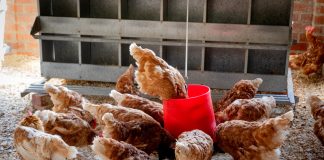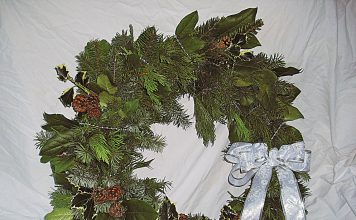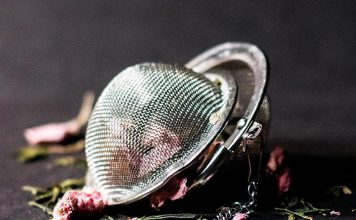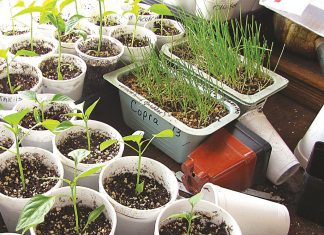 |
|
| Issue #155 • September/October, 2015 |

Currants and gooseberries all belong to the genus Ribes (pronounced “rye-bees”). There are varieties of currants and gooseberries native to Europe and North America, along with some developed by breeders. The jostaberry is a cross between the gooseberry and the black currant. Ribes are very cold-tolerant, so northern regions are particularly suitable for their cultivation.
Currants and gooseberries may actually be prohibited in your area due to their ability to host white pine blister rust, which can kill off white pine trees. The fungus must spend some part of its life on leaves of this genus, and the black currant is particularly obliging. There was a federal ban in the 1920s and a lot of resources went into trying to eradicate all gooseberries and currants, particularly in places where white pines were the mainstay of the lumber/logging business. In the 1960s, the federal ban was lifted and the responsibility shifted to the states, some of which still ban importation. The websites or catalogs of various nurseries will tell you whether they can ship a particular plant to your state.
Currants
Currants are available in a variety of colors, mainly black and red. Their size varies from the size of a pea to that of a marble. Some varieties of currants are grown for their fragrant and beautiful flowers. Currants have no thorns, usually grow less than six feet tall, and produce fruit with several small seeds. Currants will live as long as 20 years if you take care of them.
Red currants are quite different from black ones. The skins of the ripe berries are translucent; held to the light, you can see the seeds inside. A whole raceme (fruiting branch) can be snapped off at one time, making picking easier. Red currants are tart and make a wonderful jelly.
Some red currant bushes are short and sprawly and some stand up to six feet tall. In Montana, they ripen in late July into August. They continue to send up new shoots every year, but they do not sucker and spread.
Black currants, on the other hand, will keep sending up suckers to create a thicket. These can be dug up with their root and transplanted to another location or shared with a friend.
There are a number of different currants, many of which grow somewhere in the wild. At one point, I had a wild currant with green blossoms that did not produce; I later learned that some black currants require a pollinator, and some simply don’t taste good. Now, I prefer to buy my plants from trusted sources.
The juice of the black currant is rich in vitamin C. I like to use the small berries in place of blueberries in muffins; they also make a wonderful jam. The berries ripen gradually, so I pick them over a period of time. Birds also find them tasty, so I have to be vigilant to get my share. Each berry must be picked separately so it is a bit time-consuming.

Black currants in various stages of maturity
Gooseberries
The gooseberry itself can vary in color from green to red to black and look translucent or solid-colored, depending upon the variety. Most of mine are about ¾-inch in diameter.
I chose my varieties of gooseberry based on what was available at my local nurseries. Many seed catalogs offer at least one and sometimes several varieties from which to choose.
My first gooseberry was a Canadian variety, Captivator, which is somewhat thornless. The berries will get darkish red when ripe. The berries have the typical tough skin of a gooseberry and remain firm to maturity. Once I removed the grass growing around this plant, it produced generously.
Next, I purchased a Black Velvet. Its berries are nearly black when ripe and very juicy. These berries are sweet and mild and some say they taste a bit like blueberries. The thorns are noticeable on this one. This is the tallest bush I have, at about five feet tall.
Then, a Red Hinnomaki, a gooseberry from Finland, joined the lineup. It has tasty red berries and is very thorny. This one is a short bush, growing only two feet tall.

Red currants on the bush
Planting
When planting, think location. Ribes grow in Zones 3-7 or 8. I am on the border of Zones 4 and 5, and my currants and gooseberries are doing well. Ribes are a good choice for cold areas, because they tolerate extreme cold, but heat can be a problem. They like cool, moist soils with a slightly acidic pH (5.5 to 6.8).
Gooseberry plants can grow six feet high and spread out four feet wide. So far, most of the ones I have are around three feet tall. Most gooseberry plants have thorns, which can make picking them a bit hazardous. Do not plant them against a wall or close together; it is easier to harvest if you have access to all sides of the bush. Gooseberries tolerate afternoon shade (in hot climates they need it) and cool soil. Try planting them on the north side of a building.
Clay soil retains moisture better than sandy soil, so that would be preferable, but as long as you keep the soil moist (not soggy) and cool, the plants will be fine.
If you are buying bare-root plants, plant in fall or very early spring. The potted ones can be planted at any time. Ribes start their season early and their best growth time is spring, so it is best not to interrupt this.
Set the plant a little lower in the soil than it had been before; this will encourage it to make more roots and help keep it from drying out. Roots tend to grow shallowly, so make the hole fairly wide and add some organic material if you have heavy clay soil. Regular watering and some mulch will keep the plant happy.
Drip irrigation can be beneficial by keeping water off the leaves. Dry plants resist fungal diseases.
Plant maintenance
There are several ways to go about pruning gooseberries. One way is to train it to one main stem sort of like a tree and allow branches which you will prune from time to time. Another way is to let it keep sprouting up new shoots while you prune out the older ones. That rotation is about four years, allowing for about four new shoots each year and eliminating the oldest four shoots in the fourth year. The best production of gooseberries comes from one- to four-year-old shoots.
However, black currants differ in that they produce on one-year-old wood. I have found that the bushes find a way to produce fruit even if I don’t prune them. They add branches or side shoots for that purpose. Without some pruning, though, it can get to be a crowded mess.
In addition to regular pruning, you can cut away a quarter to a half of the new growth on established shoots to encourage production of a sturdier shoot.
Where you plant and what you want the plant to look like will ultimately determine how you prune. Taylor’s Guide to Fruits and Berries by Roger Holmes gives some wonderful diagrams of different pruning methods. Pruning can be done in late fall or late winter.
I have not yet needed to fertilize my plants, but I am lucky to have fairly good soil with balanced pH. However, gooseberries do need potassium and magnesium, so add as needed.

Black Velvet gooseberry nearly ripe
Pests and diseases
Depending where you live, there are a number of pests that can cause problems: aphids, spider mites, clear-winged borers, gooseberry sawflies, and imported currant worms.
Aphids attacked my red currant plant, causing the leaves to blister a purplish color. I ended up dousing the plant with insecticidal soap and pruning it to the ground that season. Plenty of new shoots came up the next year.
I have also had a problem with the imported currant worm in both my red currant and my gooseberries. I think they came in the soil of the potted plant. They are small green worms with a black spot on their heads. They eat the leaves until there is nothing but a skeleton left. A group of these can defoliate a plant in short order. I tried picking and crushing them by hand, but I could not keep ahead of them. Treating with Bt doesn’t work, because the “worms” are actually the larvae of a fly, not a true worm. Pyrethrum is the organic spray that seems to work. Several generations of worms are possible in one year, so I keep an eye out for the first ones and hit them hard, hoping I don’t have to keep doing it all summer.
I have not had any problem with spider mites, clear-winged borers, or gooseberry sawflies. These are rare, but I mention them in case they happen to be a problem in your area.
I have been fortunate that my bushes have not had any diseases. There are, however, a couple to be aware of. Leaf spot and powdery mildew can plague Ribes. Luckily, both of these fungal diseases can be controlled with copper spray.
Harvesting
Before harvesting, you need to know what color your particular variety of Ribes will be when it is ripe, since ripe berries can be green, pink, red, yellow, or black. My currants ripen in July, while the gooseberries slowly ripen from July to late August or even September. If birds or neighbors don’t pick them, berries can be left on the bush for quite a while.
When you pick them may depend on what you plan to use them for. Slightly underripe berries do nicely in jam, but fully ripe ones taste better fresh.
Picking gooseberries must be done carefully those thorns hurt. Once you get a bunch of berries picked, you have to remove the stems and tails, on gooseberries and currants alike. I do it with kitchen shears, clipping as close to the berry as possible. Bigger berries make this task easier.
For me, freezing is the easiest way to preserve these berries. Once I’ve removed all the stems and tails from the berries, I rinse, pat dry, then put into containers and freeze.

Captivator gooseberry
Canning
Gooseberries and jostaberries can be home-canned plain using either the cold-pack method or the hot-pack method. If you are interested in storing them in this manner, check out the Ball Blue Book or your favorite canning book, such as Jackie Clay’s Growing and Canning Your Own Food.
However, I prefer to make jams and jellies from these delicious berries.
Red currant jelly
Red currants have considerable natural pectin, so it’s not necessary to add pectin. First, wash the berries and cook them with a little water. Mash the berries as they soften. Once they are cooked and juicy, let them drain through a jelly bag. I prefer to use a flour sack dishtowel in a strainer of some kind. Measure the juice, then mix together equal parts sugar and juice. Cook until it reaches the jelling point (juice forms a sheet between the tines of a fork). Pour into jars, leaving ¼-inch headspace. Put on sterilized lids, tighten rings, and process in a boiling water bath canner for 10-15 minutes (adjust for your elevation).
If you use powdered pectin, follow the directions for sour cherries if there are none for red currants.
Gooseberry or jostaberry jam
The different varieties of gooseberries make totally different tasting jam, but the instructions are the same for all, including jostaberries. I use the low sugar recipe that comes with Pomona’s Universal Pectin.
Using a food processor, purée enough berries to make four cups. The berries are pretty solid and have tough skins, so just mashing them doesn’t work.
Put the puréed berries into a big porcelain kettle, then stir in two teaspoons of calcium water (from the packet that comes with the pectin). Stir occasionally while heating the berries.
While the berries heat up, mix two teaspoons of pectin powder into the sugar. You can use anywhere from ¾ to two cups of sugar, to taste. I tend to use about 1½ cups of sugar.
Bring the fruit to a boil, add the pectin-sugar mixture, and stir well to dissolve the sugar. Bring it to a boil again, then remove it from heat. Pour into jars, leaving ¼-inch headspace. Put on sterilized lids, tighten rings, and process in a boiling water bath canner for 10 minutes (adjust for your elevation).
To make gooseberry jam without using pectin, simply run the berries through the processor, measure out the chopped berries, cook until soft, then add ¾ cup sugar for each cup of berries. Cook the mixture until thick, then put in jars and process as above.
Black currant jam
I use the same recipe for black currant jam as I use for gooseberry jam. Black currants, however, do not need to be run through the food processor; mashing works well for them.

Gooseberry fool made from Captivator berries
Recipes
People have been eating Ribes for a very long time. One traditional dessert called gooseberry fool dates back to the late 1400s in Europe. Where the name came from is a mystery, and the ingredients are not the same in every recipe for it. Originally, the fruit purée was folded into a custard, but the more common ingredient today is whipping cream.
Gooseberry fool
2 cups berries with stems and tails removed
½ cup sugar or more, divided
2 – 3 Tbsp. water
1 cup heavy cream
Cook gooseberries in a pan that won’t react with the acid in the berries, such as a stainless steel or graniteware pan. Add the water and ¼ cup sugar. Cook gently until the berries are done and soft. Mash them and put through a food mill to make a purée. At this point, add more sugar to your taste, then cool the mixture.
In a separate bowl, whip your cream until it will hold a peak. Fold the cooled purée into the whipped cream and chill for several hours. Serve in parfait glasses or small bowls.
Gooseberry pie
Using frozen berries seems to soften the tough skins. If you use really firm fresh berries, you may need to give them a whirl in the food processor before proceeding.
3 cups frozen gooseberries
1½ cups sugar, divided
½ cup water
¼ cup flour
1 tsp. cinnamon
½ tsp. cloves
1/8 tsp. nutmeg
¼ tsp. salt
1 recipe double-crust pie pastry
1 Tbsp. butter
Combine gooseberries with 1 cup of the sugar and the water in a saucepan. Cook until berries are tender, which doesn’t take long when frozen berries thaw out. Stir in remaining sugar, flour, spices, and salt. Remove from heat and let cool.
Roll out your favorite double-crust recipe to line a 9-inch pie pan. Pour in cooled filling, dot the top with butter, and cover with top crust. Cut a few holes in the top. Sprinkle very lightly with sugar and bake in a 450° F oven for 10 minutes. Then, turn the oven down to 350° F, and bake for another 25 minutes.


